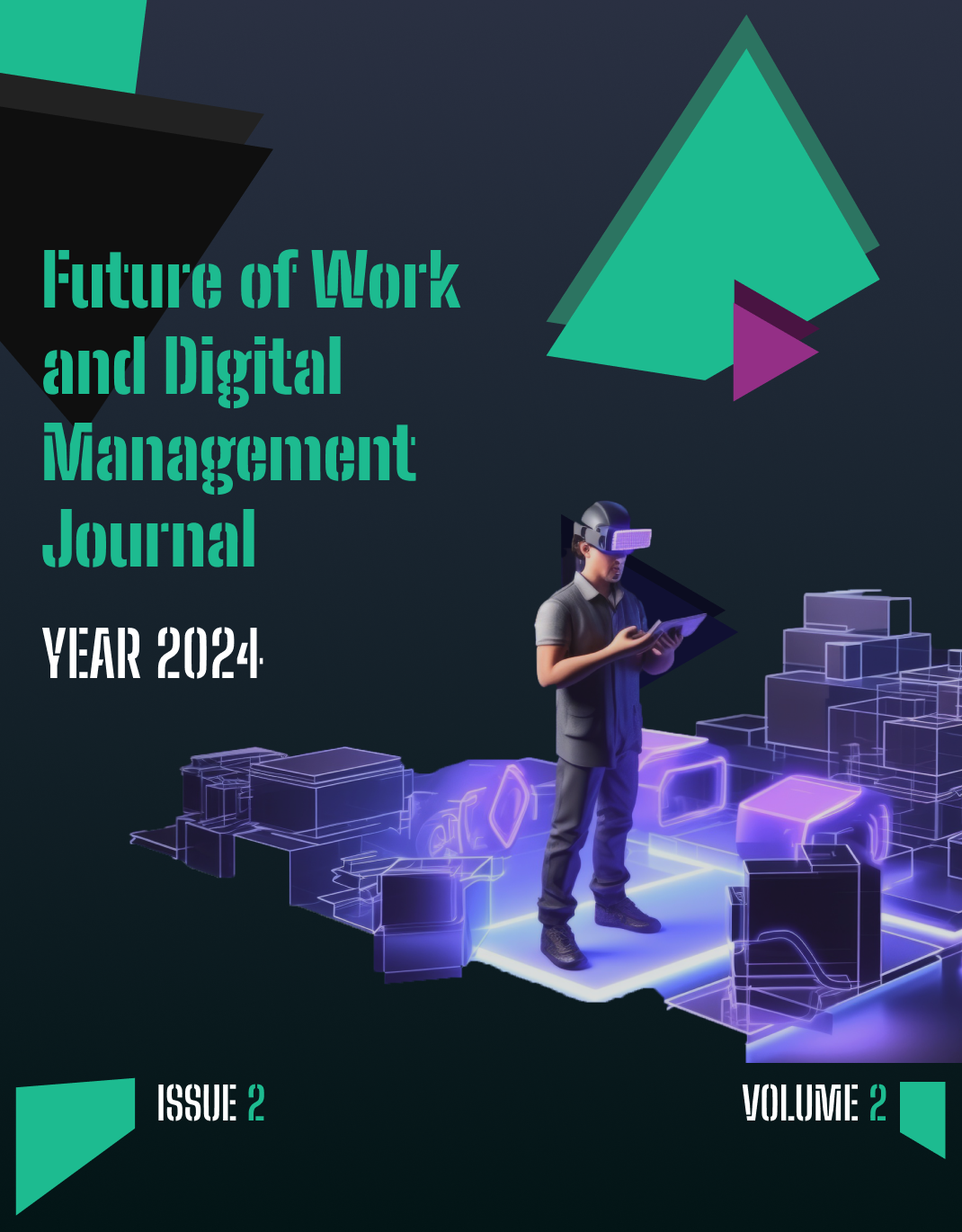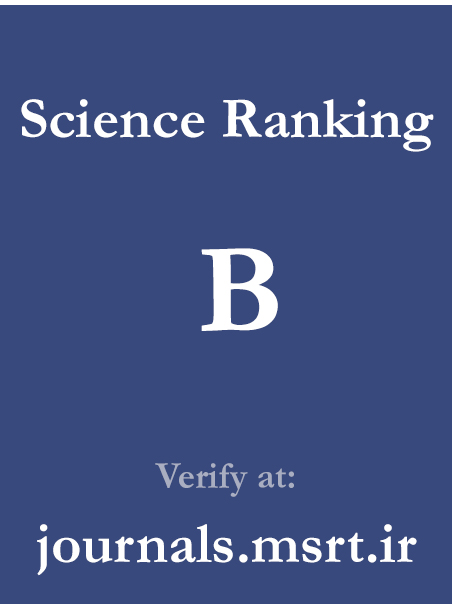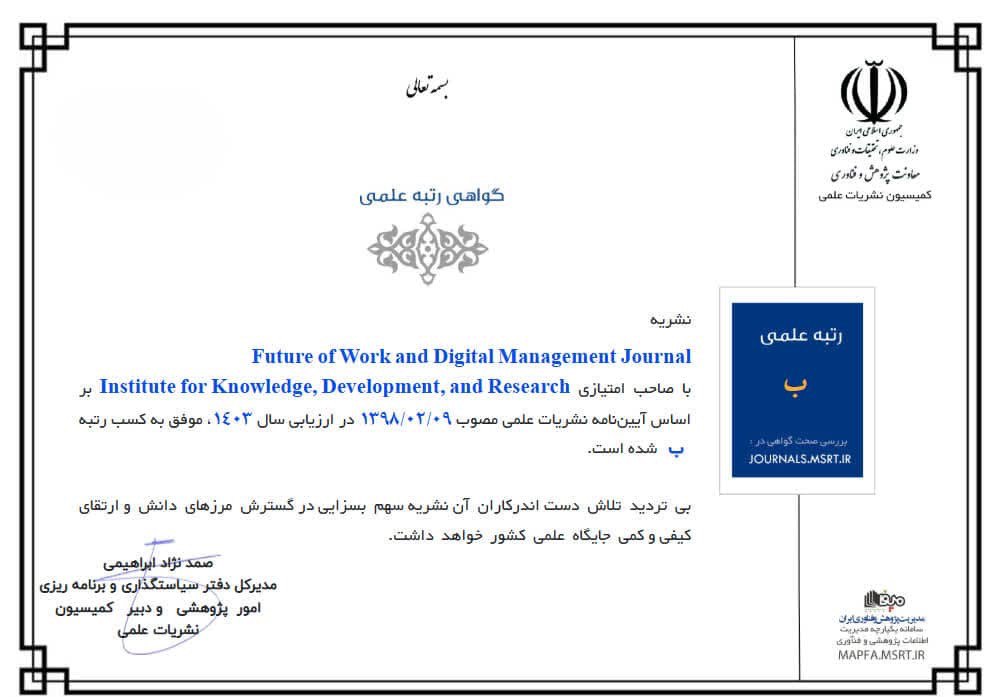Digital Monitoring and Burnout: The Mediating Role of Perceived Control
Keywords:
Digital monitoring, Burnout, Perceived control, Workplace surveillance, Structural equation modeling, Occupational stressAbstract
This study aimed to investigate the relationship between digital monitoring and employee burnout, examining the mediating role of perceived control in this association. A descriptive-correlational design was employed with a sample of 285 full-time employees from various sectors. Participants completed three standardized instruments: the Electronic Monitoring and Surveillance Scale (EMSS) for digital monitoring, the Pearlin Mastery Scale (PMS) for perceived control, and the Maslach Burnout Inventory (MBI) for burnout. Data were analyzed using Pearson correlation, structural equation modeling (SEM), and mediation analysis in SPSS-27 and AMOS-24. The goodness-of-fit indices were used to evaluate the model’s fit, including χ²/df, GFI, AGFI, CFI, TLI, and RMSEA. Inferential analysis revealed that digital monitoring was positively associated with burnout (β = 0.34, p < .001) and negatively associated with perceived control (β = −0.31, p < .001). Perceived control was significantly negatively associated with burnout (β = −0.43, p < .001). Mediation analysis indicated a significant indirect effect of digital monitoring on burnout through perceived control (β = 0.13, p = .001), and the total effect of digital monitoring on burnout was significant (β = 0.47, p < .001). Model fit indices confirmed good model fit (χ²/df = 2.05, GFI = 0.94, AGFI = 0.91, CFI = 0.96, TLI = 0.95, RMSEA = 0.061). The findings suggest that digital monitoring contributes to higher levels of employee burnout both directly and indirectly by reducing perceived control. Perceived control plays a protective, mediating role and should be considered a crucial psychological factor when designing and implementing monitoring technologies in the workplace.
Downloads
References
[1] Z. T. Rony and H. D. Pardosi, "Burnout Digital Monitoring on Employee Engagement at the Company," International Journal of Research in Business and Social Science (2147-4478), vol. 10, no. 7, pp. 156-162, 2021, doi: 10.20525/ijrbs.v10i7.1412.
[2] J. J. Lang, Y. Li, C. Cheng, X. Y. Cheng, and F. Y. Chen, "Are Algorithmically Controlled Gig Workers Deeply Burned Out? An Empirical Study on Employee Work Engagement," BMC Psychology, vol. 11, no. 1, 2023, doi: 10.1186/s40359-023-01402-0.
[3] M. Masoomi, n. jamshidnejad, m. kianidehkordi, f. Ghasempour, and S. Gholamzad, "The Effectiveness of a Balint Group on Burnout Prevention, Reduction of Stress Perception, and Improvement of Caring Behaviors in Nurses in the COVID-19 Ward at Amir-Alam Hospital," 2023, doi: 10.21203/rs.3.rs-2733482/v1.
[4] T. Zhou et al., "Burnout and Well-Being of Healthcare Workers in the Post-Pandemic Period of COVID-19: A Perspective From the Job Demands-Resources Model," BMC Health Services Research, vol. 22, no. 1, 2022, doi: 10.1186/s12913-022-07608-z.
[5] A. A. D. Cruz, "Direct and Indirect Factors Affecting Teachers’ Burnout in the New Normal," Recoletos Multidisciplinary Research Journal, vol. 8, no. 2, pp. 75-86, 2020, doi: 10.32871/rmrj2008.02.06.
[6] G. Greco, "Effects of Combined Exercise Training on Work-Related Burnout Symptoms and Psychological Stress in the Helping Professionals," Journal of Human Sport and Exercise, vol. 16, no. 2, 2020, doi: 10.14198/jhse.2021.162.16.
[7] S. A. Holzgang, A. P. Pazhenkottil, M. Princip, B. Auschra, S. Euler, and R. v. Känel, "Burnout Among Male Physicians: A Controlled Study on Pathological Personality Traits and Facets," Psych, vol. 5, no. 1, pp. 1-13, 2022, doi: 10.3390/psych5010001.
[8] G. M. García and J. C. A. Calvo, "The Threat of COVID‐19 and Its Influence on Nursing Staff Burnout," Journal of Advanced Nursing, vol. 77, no. 2, pp. 832-844, 2020, doi: 10.1111/jan.14642.
[9] V. Cece, G. Martinent, E. Guillet‐Descas, and V. Lentillon‐Kaestner, "The Predictive Role of Perceived Support From Principals and Professional Identity on Teachers’ Motivation and Well-Being: A Longitudinal Study," International Journal of Environmental Research and Public Health, vol. 19, no. 11, p. 6674, 2022, doi: 10.3390/ijerph19116674.
[10] C. M. Holmes and K. Iwanaga, "Parental Burnout, Quality of Life, and Pregnancy During COVID-19," The Family Journal, vol. 32, no. 2, pp. 269-276, 2023, doi: 10.1177/10664807231173693.
[11] D. Yıldırım, C. Ç. Yıldız, and M. H. Özdoğan, "The Effects of Mindfulness-Based Breathing on Strain, Burden, and Burnout in Family Caregivers of Palliative Care Patients," Holistic Nursing Practice, 2024, doi: 10.1097/hnp.0000000000000685.
[12] M. Guangya, C. Po-Chien, L. I. N. Ying-Yin, and K. W. Io, "The Influence of Teacher-Student Relationship Conflict on University Teacher Job Burnout: The Role of Perceived Control and Political Skill," Journal of Macau University of Science and Technology, vol. 16, no. 2, p. 13, 2022, doi: 10.58664/mustjournal.2022.02.013.
[13] C. Degachi, M. L. Tielman, and M. A. Owayyed, "Trust and Perceived Control in Burnout Support Chatbots," pp. 1-10, 2023, doi: 10.1145/3544549.3585780.
[14] D. Vandermeulen, S. H. Aslih, E. Shuman, and E. Halperin, "Protected by the Emotions of the Group: Perceived Emotional Fit and Disadvantaged Group Members’ Activist Burnout," Personality and Social Psychology Bulletin, vol. 49, no. 7, pp. 1086-1096, 2022, doi: 10.1177/01461672221092853.
[15] C. Liu et al., "Mediating Role of Perceived Social Support in the Relationship Between Perceived Stress and Job Burnout Among Midwives in the Post‐COVID‐19 Era," Nursing Open, vol. 10, no. 2, pp. 479-487, 2022, doi: 10.1002/nop2.1313.
[16] J. Hudziak et al., "Psychometric Properties of a Novel Burnout Assessment Instrument: Individualized Burnout and Contributors Scale (IBOCS)," 2021, doi: 10.21203/rs.3.rs-1053776/v1.
[17] M. Makara‐Studzińska, M. Załuski, P. Jagielski, D. Wójcik-Małek, and M. Szelepajło, "An Exploration of Perceived Stress, Burnout Syndrome, and Self-Efficacy in a Group of Polish Air Traffic Controllers and Maritime Navigators: Similarities and Differences," International Journal of Environmental Research and Public Health, vol. 18, no. 1, p. 53, 2020, doi: 10.3390/ijerph18010053.
[18] X. Zhu et al., "Effectiveness of Mind-Body Exercise on Burnout and Stress in Female Undergraduate Students," International Journal of Mental Health Promotion, vol. 23, no. 3, pp. 353-360, 2021, doi: 10.32604/ijmhp.2021.016339.
[19] L. F. Olsson, D. J. Madigan, A. P. Hill, and M. C. Grugan, "Do Athlete and Coach Performance Perfectionism Predict Athlete Burnout?," European Journal of Sport Science, vol. 22, no. 7, pp. 1073-1084, 2021, doi: 10.1080/17461391.2021.1916080.
[20] h. choi, Y. Jeong, and S.-K. Kim, "The Relationship Between Coaching Behavior and Athlete Burnout: Mediating Effects of Communication and the Coach–Athlete Relationship," International Journal of Environmental Research and Public Health, vol. 17, no. 22, p. 8618, 2020, doi: 10.3390/ijerph17228618.
[21] H. Khatatbeh, S. Hammoud, M. Khatatbeh, A. Oláh, and A. Pakai, "Paediatric Nurses' Burnout and Perceived Health: The moderating Effect of the Common Work‐shift," Nursing Open, vol. 9, no. 3, pp. 1679-1687, 2022, doi: 10.1002/nop2.1192.
Downloads
Published
Submitted
Revised
Accepted
Issue
Section
License

This work is licensed under a Creative Commons Attribution-NonCommercial 4.0 International License.








